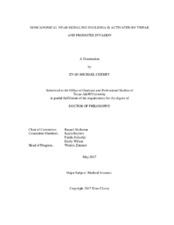Noncanonical NF-κB Signaling in Glioma is Activated by TWEAK and Promotes Invasion
Abstract
High-grade gliomas are an invasive and deadly brain cancer. We have shown that noncanonical NF-κB/RelB signaling can drive invasion in the aggressive mesenchymal subtype of glioma. TNF-like weak inducer of apoptosis (TWEAK) can activate canonical/RelA and noncanonical/RelB NF-κB signaling, but its role in glioma invasion is unclear. Moreover, the relevance of expression of TWEAK and NF-κB-inducing Kinase (NIK) in patient gliomas is unknown.
TWEAK-regulated NF-κB signaling and cell invasion were investigated in both established and primary high-grade glioma tumor lines using a three-dimensional (3-D) collagen invasion assay. NF-κB proteins regulating both glioma cell invasion and expression of Matrix Metalloproteinase 9 (MMP9) in response to TWEAK were evaluated using shRNA-mediated loss-of-function. NIK-promoted glioma growth in vivo was investigated using an orthotopic xenograft mouse model. Expression of TWEAK, its receptor, NIK, and a negative regulator of NIK (altogether termed the TWEAK Axis) in glioma tumors was evaluated using microarray data from the NCI-curated TCGA and REMBRANDT databases. TWEAK Axis expression was stratified by prognostic factor and glioma subtype as well as correlated with expression of both NF-κB genes and glioma subtype markers. Patient survival by TWEAK Axis gene expression was determined using Kaplan-Meier survival analysis.
Protein levels of RelB correlate positively with glioma cell invasiveness. Loss of RelB attenuates invasion without altering RelA expression or phosphorylation. RelB promotes invasion independent of RelA. TWEAK selectively activates noncanonical NF-κB signaling through p100-p52 processing and nuclear accumulation of RelB and p52. TWEAK, but not TNFα, significantly increases NIK mRNA expression and sustains MMP9 mRNA expression. TWEAK-increased invasion is reversible by loss of NIK. NIK overexpression increases invasiveness in vitro and gliomagenesis in vivo. TWEAK, its receptor, and NIK are expressed primarily in mesenchymal gliomas and correlate negatively with survival.
Our data establish a key role for NIK and TWEAK in noncanonical NF-κB signaling and MMP9-dependent invasion in glioma cells. Meta-analysis of patient glioma tumors indicates poorer prognosis with increased TWEAK Axis expression in the aggressive mesenchymal subtype. Together, these studies reveal the importance of TWEAK and noncanonical NF-κB signaling in glioma cell invasion and rationalize therapeutic targeting of TWEAK and NIK in glioma.
Citation
Cherry, Evan Michael (2017). Noncanonical NF-κB Signaling in Glioma is Activated by TWEAK and Promotes Invasion. Doctoral dissertation, Texas A & M University. Available electronically from https : / /hdl .handle .net /1969 .1 /161267.


